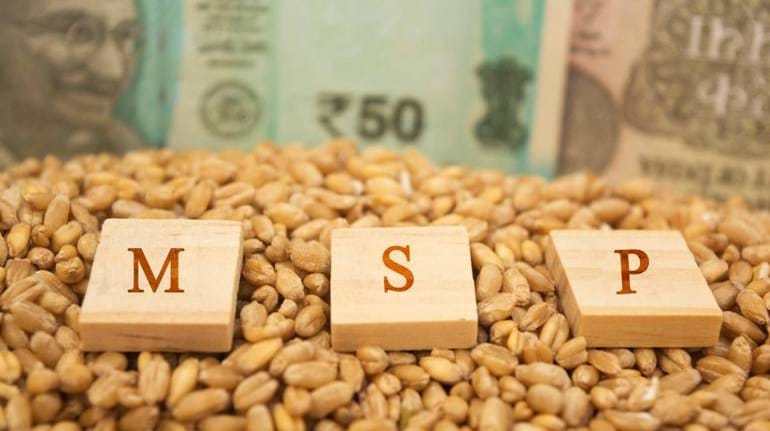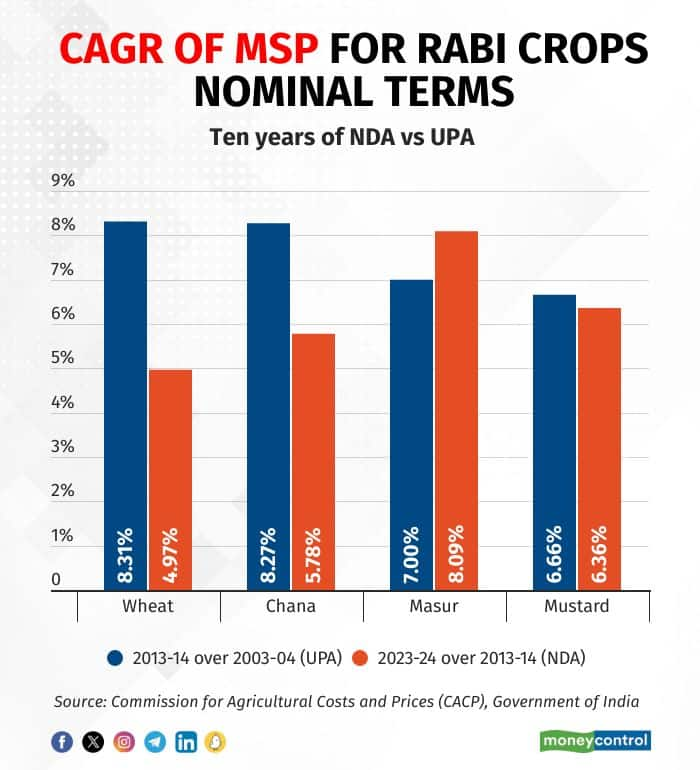



Amidst a period of elevated food inflation brought by adverse climatic conditions starting in February 2022, the government has realised that it cannot be ‘business as usual’ for the support prices. The minimum support price (MSP) of wheat and masur for 2023-24 has increased by 7.1 percent over the previous year. This is the highest increase in the last ten years. However, the NDA government has generally given a lower hike in MSP than the previous UPA government.
Economists have often pointed to the MSP as an important factor contributing to food inflation. Retail food inflation in the latter years of the Manmohan Singh government was in double digits — 10.2 percent in 2012 (January-December) and 12.4 percent in 2013. During the NDA period, food inflation was much lower at 6.8 percent in 2022 and 6.2 percent in 2023 (January-September). No government can ignore food security. As wheat and rice are distributed to 81.35 crore people under the National Food Security Act 2013, the government needs to procure sufficient quantities of the two food grains. An attractive MSP is therefore important for procurement by the government.
MSP Rise in Nominal Terms
The decision to give a handsome increase in MSP of Rabi crops of 2023-24 should be seen in this light.
This was the final round of MSPs declared in the ten years of the NDA government. It provides a fair opportunity to compare the hikes in the ten years of the UPA and NDA governments.

The MSP of wheat was increased by the UPA government from Rs 630 per quintal in 2003-04 to Rs 1,400 in 2013-14. Over the ten-year period of the NDA government, it has increased from Rs 1,450 per quintal to Rs 2,275 per quintal. In nominal terms, the MSP for wheat increased at a compound annual growth rate (CAGR) of almost 5 percent during the NDA period compared to 8.3 percent in the UPA period.
Subramanian Committee Recommendations
In 2015, the Modi Government set up a committee under Arvind Subramanian, the then chief economic advisor, to study how the production of pulses can be increased. The committee submitted its report in September 2016 (Incentivising pulses production through minimum support price and related policies). It gave several important recommendations including an immediate and substantial hike in MSP of pulses.
For Rabi 2016-17, it recommended an increase in the MSP of chana (from Rs 3,425 per quintal) to Rs 4,000 per quintal. For urad and tur crops of Kharif 2016, it recommended an MSP of Rs 6,000 per quintal (from Rs 5,050 per quintal for tur and Rs 5,000 per quintal for urad announced before the submission of the report). The committee further recommended that the Commission for Agricultural Costs and Prices (CACP) should also consider risks and externalities while recommending the MSP of pulses.
How much weight has been given by the NDA government to the recommendations of the committee over the years?
MSP Hike by NDA and UPA
The MSP of gram (chana) has seen an increase of 5.8 percent in (nominal) CAGR terms in the NDA period compared to 8.3 percent in the UPA period. The NDA government has however given a substantial hike in the MSP of masur. It was raised at a CAGR of 8.1 percent in the NDA period against 7 percent in the UPA period. As a result, the production of masur went up from 1.01 million tonnes in 2013-14 to 1.59 million tonnes (2nd Advance Estimates) in 2022-23. In the ten years of the UPA government, the MSP of tur was increased by a CAGR of 12.2 percent while the NDA government increased it by only about 5 percent. Similarly, the CAGR of MSP of urad was 12.1 percent during the UPA term compared to 4.9 percent during the NDA period.
The moderate rate of increase in the MSP of pulses is rather surprising as the NDA government has been quite focused on self-sufficiency in pulses. It did well to set up a buffer stock of pulses not only to help farmers realise the MSP but also to check inflation. For this, the NDA government also set up the Price Stabilisation Fund in 2015 which is used for the purchase of pulses (as well as other commodities like onions or tomatoes) even at market prices, which could be higher than the MSP.

Similarly, in the case of paddy, the UPA government provided a substantially higher increase in the MSP. It was increased at CAGR of 9.1 percent in the UPA period against 5.2 percent in the NDA period.
The importance of MSP for the food security of India has not gone down despite the need to diversify Indian diets from too much of cereals to proteins. Since the public distribution system provides food grains only in physical form, the government has to procure, store, transport and distribute wheat and rice across India. The biggest experiment of direct benefit transfer of money in lieu of food grains is underway in Karnataka. If it succeeds, it is possible that other agriculturally surplus states like Punjab, Haryana and Andhra Pradesh may consider giving cash rather than wheat and rice. This can enable the beneficiaries to buy more nutritious food items. From a ten-year perspective, this may bring changes in the policy on MSP.
Siraj Hussain is a former Union agriculture secretary. Kriti Khurana is a PhD scholar of economics at BITS Pilani, Hyderabad. Views are personal, and do not represent the stand of this publication.
Discover the latest Business News, Sensex, and Nifty updates. Obtain Personal Finance insights, tax queries, and expert opinions on Moneycontrol or download the Moneycontrol App to stay updated!
Find the best of Al News in one place, specially curated for you every weekend.
Stay on top of the latest tech trends and biggest startup news.